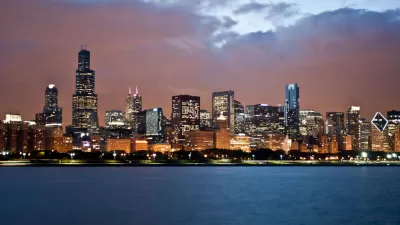Why are folks fleeing from the city and the state in record numbers? Is domestic migration to blame for the Chicago region's population loss last year of over 6,000 and the state's loss of over 22,000 people?

[Updated 5/5/2016] "By almost every metric, Illinois' population is sharply declining, largely because residents are fleeing the state," writes Marwa Eltagouri for the Chicago Tribune. "Census data released [March 24] suggest the root of the problem is in the Chicago metropolitan area, which in 2015 saw its first population decline since at least 1990."
A Chicago Tribune graph of a William Frey analysis of Census data for the Chicago, three-state metropolitan statistical area shows a loss of over 6,000 residents from July 2014 to July 2015, "the greatest loss of any metropolitan area in the country," notes Eltagouri. That's net loss after considering births, deaths, and immigration, not just migration to other states.
A second graph shows population change in seven counties in the Chicago-Naperville-Elgin, Illinois metropolitan area. Cook County, which contains Chicago saw the greatest population loss, 11,000 residents, or 0.20 percent. The state population dropped by 22,000, or .17 percent. Only West Virginia had a higher rate of loss among the seven states that lost population last year, adds Eltagouri. In 2014, the state's population dropped by over 7,000 people.
"The plunge is mainly a result of the large number of residents leaving the state last year — about 105,200 in all — which couldn't be offset by new residents and births, according to census data," adds Eltagouri. "The last year Illinois saw its population plunge was 1988."
Derek Thompson, senior editor at The Atlantic, might take issue with that assessment that domestic migration is the chief cause, at least when it applies to Chicago, if not the state.
In case you didn't click on the Here & Now WBUR/NPR report, "Chicago Loses Population As Sun Belt Cities Grow", that appeared at the bottom of a post last month on urban demographics, here it is again, along with excerpts below it to tempt you to listen.
Here & Now's host, Jeremy Hobson, asks, "Why are so many people leaving Chicago? According to the Census, Chicago is shrinking in population, while other major cities are growing and more people are moving to the sunbelt."
"I have to say I was shocked by these figures," responds Thompson, "but the city is shrinking, and the reasons why are really important for all cities to look at because Chicago in this way could be an inauspicious omen for other large American cities."
- "First of all, Chicago is suffering from really low immigration compared to a lot of other major cities.
- "Second, its richest areas are losing population perhaps as it's getting too expensive to live there."
That's exactly what's resulting from new transit oriented developments, according to a post on Monday, though Yonah Freemark argues as project manager at the Metropolitan Planning Council "that displacement might have been much worse if not for the new development."
- "The city is getting a lot older which is affecting its birth-to-death ratio, not good to the growth of the city.
- "And finally, black people are leaving by the tens of thousands as we have seen a lot of racial strife."
A post in March attributes the black exodus to crime and economic improvement.
The Tribune also offered similar reasons for the population decline:
The main factors in Chicago's population dip are diminished immigration, the aging of the Mexican immigrant population that bolstered the city throughout the 1990s as well as an exodus of African-Americans, experts say.
More than any other city, Chicago has depended on Mexican immigrants to balance the sluggish growth of its native-born population, said Rob Paral, a Chicago-based demographer who advises nonprofits and community groups. During the 1990s, immigration accounted for most of Chicago's population growth
Thompson adds that Chicago is not benefiting from the millennial influx seen in a handful of cities like Seattle, Washington, New York, and San Francisco, "but the rest of country is basically living like it's 2006 again. They are moving to the sunny suburbs of Florida, Texas, and Arizona."
The reason why cities are growing right now is because not only do you have young people moving in, most importantly you have lots and lots of immigrants. But a lot of native born Americans, particularly those in their 30s and above, they are heading out where housing is cheaper, and that is in the sunbelt.
Interestingly, affordable housing did not appear to be one of the top reasons The Tribune found for residents leaving Chicago. "Common reasons include high taxes, the state budget stalemate, crime, the unemployment rate and the weather," writes Eltagouri. "The greatest concern, however, seems to be safety. Despite being the nation's third most populous city, Chicago outpaces New York City and Los Angeles in the number of homicides and shootings, though it fares better than some smaller cities on a per capita comparison."
"Is there anything Chicago can do to turn things around?" asks Here & Now's Thompson. Hobson suggests focusing on immigration, but not from a Donald Trump-like perspective.
I think you have to pay attention to the fact that it is normal right now for cities to be losing domestic migrants. The way that cities grow is through immigration, and the entire reason why Chicago isn't growing and that the reason it is shrinking is that immigrants aren't moving there.
Hobson's solution is to make cities attractive to immigrants. "How can create places to them to live, create jobs for them to do?" he asks.
[The post was updated to correct the location of the state capital.]
FULL STORY: Chicago area sees greatest population loss of any major U.S. city, region in 2015

Alabama: Trump Terminates Settlements for Black Communities Harmed By Raw Sewage
Trump deemed the landmark civil rights agreement “illegal DEI and environmental justice policy.”

Study: Maui’s Plan to Convert Vacation Rentals to Long-Term Housing Could Cause Nearly $1 Billion Economic Loss
The plan would reduce visitor accommodation by 25% resulting in 1,900 jobs lost.

Planetizen Federal Action Tracker
A weekly monitor of how Trump’s orders and actions are impacting planners and planning in America.

DC Extends Application Window for Outdoor Dining Permits
District restaurants will have until the end of November to apply, but businesses with permits in rush hour parking lanes must end operations on July 31.

Wind Energy on the Rise Despite Federal Policy Reversal
The Trump administration is revoking federal support for renewable energy, but demand for new projects continues unabated.

Passengers Flock to Caltrain After Electrification
The new electric trains are running faster and more reliably, leading to strong ridership growth on the Bay Area rail system.
Urban Design for Planners 1: Software Tools
This six-course series explores essential urban design concepts using open source software and equips planners with the tools they need to participate fully in the urban design process.
Planning for Universal Design
Learn the tools for implementing Universal Design in planning regulations.
Caltrans
Smith Gee Studio
Institute for Housing and Urban Development Studies (IHS)
City of Grandview
Harvard GSD Executive Education
Toledo-Lucas County Plan Commissions
Salt Lake City
NYU Wagner Graduate School of Public Service




























